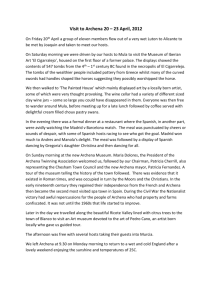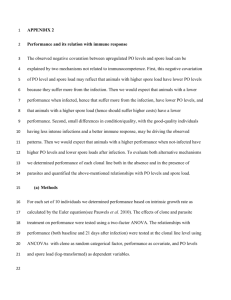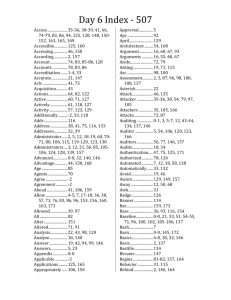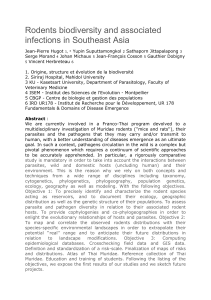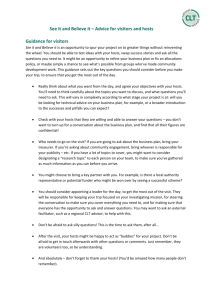ele12468-sup-0004-SupInfo
advertisement
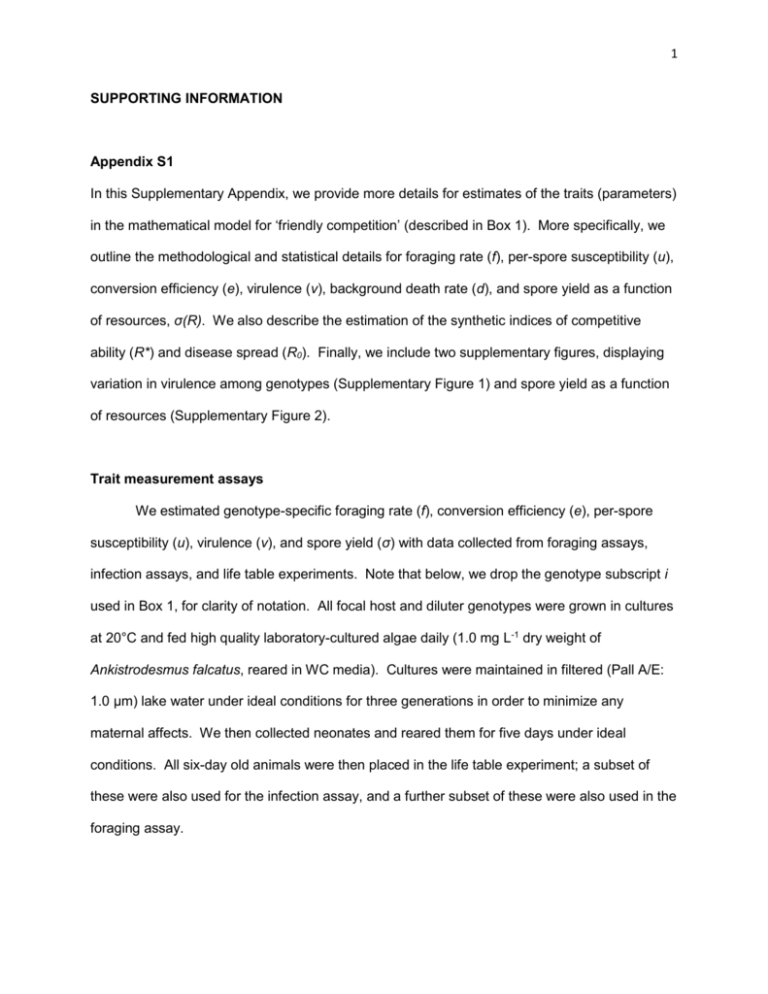
1 SUPPORTING INFORMATION Appendix S1 In this Supplementary Appendix, we provide more details for estimates of the traits (parameters) in the mathematical model for ‘friendly competition’ (described in Box 1). More specifically, we outline the methodological and statistical details for foraging rate (f), per-spore susceptibility (u), conversion efficiency (e), virulence (v), background death rate (d), and spore yield as a function of resources, σ(R). We also describe the estimation of the synthetic indices of competitive ability (R*) and disease spread (R0). Finally, we include two supplementary figures, displaying variation in virulence among genotypes (Supplementary Figure 1) and spore yield as a function of resources (Supplementary Figure 2). Trait measurement assays We estimated genotype-specific foraging rate (f), conversion efficiency (e), per-spore susceptibility (u), virulence (v), and spore yield (σ) with data collected from foraging assays, infection assays, and life table experiments. Note that below, we drop the genotype subscript i used in Box 1, for clarity of notation. All focal host and diluter genotypes were grown in cultures at 20°C and fed high quality laboratory-cultured algae daily (1.0 mg L-1 dry weight of Ankistrodesmus falcatus, reared in WC media). Cultures were maintained in filtered (Pall A/E: 1.0 µm) lake water under ideal conditions for three generations in order to minimize any maternal affects. We then collected neonates and reared them for five days under ideal conditions. All six-day old animals were then placed in the life table experiment; a subset of these were also used for the infection assay, and a further subset of these were also used in the foraging assay. 2 Estimation of foraging (exposure) rate (f) Foraging assay: We calculated foraging rate by comparing fluorescence of ungrazed and grazed algae (Sarnelle & Wilson 2008). We transferred 20 six-day old animals of each genotype individually into culture tubes containing 20 mL of filtered lake water and 1.0 mg L-1 dry weight A. falcatus. We also included eight tubes with algae but without hosts (to serve as ungrazed controls). All tubes were placed in a tube rotator, which continuously resuspended algae. Hosts were allowed to graze at 20° C for 22 hours in complete darkness. After 22 hours, hosts were transferred into fresh 50 mL tubes as part of the life table experiment. We used in vivo fluorimetry to calculate relative fluorescence of media from all culture tubes (using a Turner Trilogy Laboratory Fluorometer). Parameter estimation: Foraging rate (f) is derived by fitting a simplified version of the “resource dynamics” equation (Box 1). Because we conducted our foraging rate assay in darkness, we assume no growth of algae occurred. Additionally, with only susceptible hosts (S) grazing, our differential equation simplifies to: 𝑑𝑅 𝑑𝑡 = −𝑓𝑅𝑆 eq. S1 Solving this exponential equation for resource density (R) yields: 𝑅𝑟𝑒𝑚 = 𝑅𝑖𝑛𝑖𝑡 exp(−𝑓𝑆𝑡) eq. S2 where Rrem is the remaining resource, Rinit is the initial resource (at time t = 0), and t is the duration of the trial (22 hours). Solving for f, then: 𝑅 𝑉 𝑓 = ln (𝑅 𝑖𝑛𝑖𝑡 ) 𝑡 𝑟𝑒𝑚 eq. S3 where 1/S was replaced with experimental volume (V). We bootstrapped 95% confidence intervals for genotype-specific foraging rates with 10,000 iterations in R (R Development Core Team 2008). 3 Estimation of per-spore susceptibility (u) Infection assay: All individuals in the foraging assay plus an additional 40 individuals from each genotype (excluding the case 1 focal host genotype for logistical constraints) were used in the infection assay (see Hall et al. 2010). We exposed individual hosts to infective spores (100 spores ml-1 or 450 spores ml-1, for 22 hours). Infection assay animals that were not part of the foraging assay were treated identically (transferred into culture tubes with 20 mL of filtered lake water and allowed to graze 1.0 mg L-1 dry weight A. falcatus for 22 hours), but were inverted every half hour instead of being placed in the tube rotator. Replication at each spore density was planned strategically based on prior knowledge of each genotype’s susceptibility (Hall et al. 2010). After 22 hours of exposure, hosts were transferred into fresh 50 mL tubes as part of the life table experiment. We then visually diagnosed infection while monitoring the life table experiment. Parameter estimation: We estimated per-spore susceptibility (u) by fitting a simplified version of the “susceptible host dynamics” equation (Box 1). By focusing only on the loss of susceptible hosts due to transmission and defining the transmission coefficient as the product of exposure and per-spore susceptibility (β = u f), we arrive at: 𝑑𝑆 𝑑𝑡 = −𝛽𝑍𝑆 eq. S4 Solving this equation for remaining susceptible hosts after exposure time t yields Srem: 𝑆𝑟𝑒𝑚 = 𝑆𝑖𝑛𝑖𝑡 exp(−𝛽𝑍𝑡) eq. S5 where Sinit is the initial number of hosts in the experiment. We estimated this β using maximum likelihood and the BBMLE package in R, with our binary infection assay data as Srem and the binomial distribution serving as the likelihood function. We generated 95% confidence intervals around β by bootstrapping our infection data with 10,000 iterations. We then calculated perspore susceptibility u (hosts spore-1) as u = β / f. We generated 95% confidence intervals around u by bootstrapping values of β / f’. 4 Estimation of conversion efficiency (e) and virulence (v) Life table experiment: All individuals in the infection assay plus an additional 10 individuals from each genotype were used in a life table experiment to estimate conversion efficiency (e) and virulence (v) (see Hall et al. 2010). These 10 new individuals were treated identically on day 6 but were not exposed to spores. Thereafter, all animals were transferred daily into 50 mL tubes with fresh filtered lake water and 1.0 mg L-1 dry weight A. falcatus. Each day we counted and removed neonates and recorded host deaths until all infected hosts died (17 days). Infected hosts were isolated in 0.25 mL lake water upon death. Note that overall births in our model (Box 1) are the product of total host density (S+I), resource density (R), foraging rate (f), and conversion efficiency (e). Although our life table experiment allows us to measure instantaneous birth rate (b) directly, we need to decouple this estimate of birth rate from the other terms in our model (i.e., foraging rate (f) and resource density (R)) that contribute to instantaneous birth rate (b). We accomplish this by estimating the conversion efficiency parameter (e), which is essentially births per food consumed. Parameter estimation (e): We estimated conversion efficiency (e) as birth rate of uninfected hosts (b) per algae consumed: 𝑏 𝑒 = 𝑓𝑅 eq. S6 where R was measured in µg L-1 of ethanol-extracted chlorophyll a). Estimation of the birth rate parameter requires summing instantaneous per capita population growth rate (r) plus background mortality rate (d); i.e., b = r + d. To estimate r, we solved the standard Euler-Lotka equation: 1 = ∑𝑡 exp(−𝑟𝑡) 𝑙𝑡 𝐹𝑡 eq. S7 Here, lt is the proportion of animals surviving to day t and Ft is the average fecundity on day t. We estimated death rate (d) by assuming that time until death followed an exponential 5 distribution. This distribution provides the likelihood (𝓁) of constant death rate (d) given the time-until-death data for each host (td): 𝓁(𝑑|𝑡𝑑 ) = 𝑑 exp(−𝑑𝑡𝑑 ) eq. S8 Since not all hosts died by the end of the experiment, we included the “censored” observations using the likelihood that the animal survived at least to the end of the experiment, te = 23 days: 𝓁(𝑑|𝑡𝑑 > 𝑡𝑒 ) = exp(−𝑑𝑡𝑒 ) eq. S9 We found the maximum likelihood estimate of d by minimizing the sum of these negative logtransformed likelihoods (eqs. 8 and 9). With our r and d estimates, we bootstrapped 95% confidence intervals for genotype-specific birth rates. Then, with estimates of f, R, and b, we calculated e and bootstrapped confidence intervals around it. Parameter estimation (v): We estimated virulence (v) as the difference in death rate between infected and uninfected hosts from the life table experiment. We estimated background death rate (d) of uninfected hosts as described above (eqs. 8 and 9). We calculated overall death rate of infected hosts (d + v) using the same equations. Then we calculated virulence (v) as the difference and bootstrapped confidence intervals around it (Fig. S1). Parameter estimation (d): Although estimating virulence and birth rate required estimating background death rate, d, our life table experiment was not designed to provide precise and accurate estimates for d. We would need a longer experiment that would allow more uninfected hosts to die naturally. As such, our current parameters likely underestimate d. Because of this uncertainty in d, we use a reasonable estimate (0.05 day-1) in all of our simulations (Hite et al. unpublished manuscript). Thus, variation in other traits (with better estimates) drives qualitative differences in synthetic indices and simulations. 6 Estimation of spore yield (σ) as a function of resources (R) Although spore yield (σ) increases with resources (R), we only measured spore yield at one resource level (using dead infected hosts from the life table experiment). We ground these hosts with an automatic pestle, counted their spores with a haemocytometer, and bootstrapped 95% confidence intervals for genotype-specific spore yields (Fig. 1 A). Then, we fit a function to pre-existing data (Hall et al. 2009) to describe how spore yield increases with resources in our model (Box 1): ̂𝜎 𝑅 𝜎(𝑅) = ℎ+𝑅 eq. S10 Here, h is the half saturation constant of spores growing within a host, R is the current concentration of resources (µg L-1 chl-a), and ̂𝜎 is the maximum spore yield for a genotype. The half saturation constant h was fitted to a single host genotype with spore yields estimated at four resource concentrations (Hall et al. 2009) (see Fig. S2 for data and confidence intervals). Then, we converted the units of h from mg L-1 dry weight to µg L-1 chl-a, using a regression of algal dry weight versus fluorescence (not shown). We estimated maximum spore yield ( ̂𝜎) for each genotype as: ̂𝜎 = 𝜎(ℎ+𝑅) 𝑅 eq. S11 Here, σ is the average spore yield measured from the life table (Fig. 1 A), R is the concentration of resources used in the life table (measured in µg L-1 of ethanol-extracted chlorophyll a), and h is the fitted half saturation constant (Hall et al. 2009) (Fig. 2). Other parameters: algal growth rate (r) and carrying capacity (K); spore loss rate (m) The estimate for algal K (250 µg L-1 chlorophyll-a) was the average ethanol-extracted chlorophyll-a from algae-only mesocosm tanks over the epidemic period (measured with a fluorometer; not shown). We assumed a reasonable estimate for maximal algal growth rate (r = 7 0.9 day-1) (Sterner & Elser 2002). Our estimates for spore loss rate m (0.2 day-1) was based on prior knowledge of our study system (Civitello et al. 2013). Synthetic indices of competitive ability (R*) and disease spread (R0) For each clonal genotype of the focal host and for the competitor/diluter, we derived R* by solving for the disease-free boundary equilibrium of our model (Box 1): 𝑑 𝑅 ∗ = 𝑒𝑓 eq. S12 We derived R0 using the next generation matrix approach, yielding: 𝑅0 = (𝑓𝑢𝑆𝑏∗ )𝜎(𝑅∗ ) 𝑚+(𝑓𝑆𝑏∗ ) eq. S13 which is the ratio of gains from infection (fuSb*) and spore release (σ(R*), following eq. S11), in the numerator, to losses of spores from spore mortality (m) and consumption (fSb*) (in the denominator). Here, Sb* is equilibrial host density at the disease-free boundary equilibrium: 𝑟 𝑓 𝑆𝑏∗ = (1 − 𝑅∗ ) 𝐾 eq. S14 where K is the carrying capacity of the algal resource (without hosts), r is maximal growth rate of the algal resource, and R* is the minimal resource requirement of the focal host or competitor/diluter (eq. 12). We generated 95% confidence intervals around R* and R0 by bootstrapping over variation in all of the parameters involved (f, u, e, and σ). 8 SUPPORTING REFERENCES 1. Civitello, D.J., Penczykowski, R.M., Hite, J.L., Duffy, M.A. & Hall, S.R. (2013). Potassium stimulates fungal epidemics in Daphnia by increasing host and parasite reproduction. Ecology, 94, 380-388. 2. Hall, S.R., Becker, C.R., Duffy, M.A. & Caceres, C.E. (2010). Variation in Resource Acquisition and Use among Host Clones Creates Key Epidemiological Trade-Offs. Am. Nat., 176, 557-565. 3. Hall, S.R., Simonis, J.L., Nisbet, R.M., Tessier, A.J. & Caceres, C.E. (2009). Resource Ecology of Virulence in a Planktonic Host-Parasite System: An Explanation Using Dynamic Energy Budgets. Am. Nat., 174, 149-162. 4. Sarnelle, O. & Wilson, A.E. (2008). Type III functional response in Daphnia. Ecology, 89, 1723-1732. 5. Sterner, R.W. & Elser, J.J. (2002). Ecological Stoichiometry: The Biology of Elements from Molecules to the Biosphere. Princeton University Press. 9 Figure S1. Variation in increased death due to virulence. Because our life table experiment was not long enough to reliably estimate background death rate d, (not enough hosts died of natural causes), we used d = 0.05 day-1 in all simulations. However, we estimated virulence v (increased death rate due to infection) for each genotype because infected hosts all died within two weeks of the life table experiment. Death rate of infected hosts was then d+v. Error bars are 95% confidence intervals. Figure S2. A functional form for the increase of spore yield with density of algal resources, σ(R), using previously published data (Hall et al. 2009). We used the half saturation constant (h) of the type II function to then map spore yield to resources for the focal hosts here (after estimating maximal spore yield, ̂ 𝜎, for each clone and converting h into appropriate chl-a units). Parameter estimates are given with bootstrapped 95% confidence intervals; the grey 95% envelope was also bootstrapped. 10 Appendix S2 In this Supplementary Appendix, we display an additional figure showing the total host densities in all simulations and mesocosm experiments. Figure S3. Variation in density of total (susceptible and infected) focal hosts and competitor/diluters depends on competitive ability (R*) and the potential for disease spread (R0) among three focal host genotypes. Solid lines: focal hosts alone; dashed lines: focal hosts with competitor/diluters; blue dotted lines: competitor/diluters with focal hosts. Error bars are standard errors. 11
